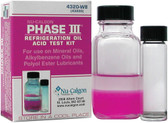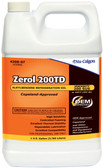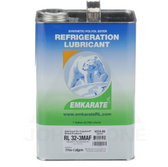 Loading... Please wait...
Loading... Please wait...Categories
Nu Calgon 4303-07 C-3 Refrigeration Mineral Oil 1 Gal
Product Description
Nu Calgon 4303-07 C-3 Refrigeration Mineral Oil 1 Gal
A COMPLETE FAMILY OF NAPHTHENIC MINERAL OILS FOR REFRIGERATION AND AIR CONDITIONING
COMPRESSORS.
• Recommended by OEM’s for use with CFC’s and HCFC’s
• Approved by OEM’s including Copeland, Carlyle, etc.
• C-3s is approved replacement for 3GS
Description
Nu-Calgon naphthenic mineral oil is available in three grades:
C-3s (150 SUS), C-4s (300 SUS) and C-5s (500 SUS). All viscosities are manufactured by Calumet Lubricant Co. and are approved by Copeland, Trane and other compressor manufacturers, approvals varying by viscosity. They are specifically designed for today’s high performance air conditioning and refrigeration compressors. These modern compressors run at higher speeds and generate higher temperatures, and they need better lubrication.
Use of C-3s, C-4s, and C-5s mineral oil will insure continued efficient system operation, providing the important properties required from a good refrigeration oil. Nu-Calgon mineral oils combine excellent solubility and stability with good floc and pour points to provide excellent low temperature performance.
Lubrication
The basic purpose of refrigeration oil is to lubricate the moving parts in an air conditioning or refrigeration compressor. The refrigeration oil must function without maintenance or service at higher than usual temperatures for the life of the unit. It must also be miscible with the refrigerant while retaining its
lubricant properties.
Nu-Calgon mineral oils are designed to provide years of trouble-free service in refrigeration and air conditioning units. There is no finer mineral refrigeration lubricant on the market today.
Low Temperature Performance
Small amounts of refrigeration oil are carried with the refrigerant through the entire system and are subject to very low temperatures. Poor low temperature solubility or miscibility can cause the oil to separate from the refrigerant and form wax-like deposits which can clog a system. And this is more critical in R-22 and R-502 systems because they have limited miscibility with mineral oil. Therefore, it is important that the mineral oil have good low temperature miscibility.
The “Floc Point Test” is used to determine low temperature performance. The floc point is determined by cooling a mixture of 10% oil and 90% refrigerant in a sealed tube. The mixture is observed at 5° increments for cloudiness due to flocculant formation.
Mineral oils from Nu-Calgon combine excellent solubility and miscibility, providing for low floc and cloud points. The above figures represent the lowest temperatures that the respective oils can be taken without the formation of wax (floc).
Stability
Refrigeration oil must have both thermal and chemical stability. Thermal stability simply means resistance to high temperature. Chemical stability refers to the oil’s ability to remain chemically stable in the presence of other components in the system at very high temperatures and pressures.
A test for refrigeration oil stability is the “fourteen day sealed tube test.” Oil, R-12 and Swedish steel are heated to 327°F in a pressure chamber. After 14 days, the percent of R-22 that has developed from the breakdown of R-12 is measured. The smaller the quantity formed, the better the stability of the
oil. Both C-3 and C-4 perform exceedingly well, forming only 0.23% and 0.42%, respectively, after 14 days.
Additional Important Points
Contamination problems are extremely critical in refining and handling refrigeration oils. Great care is used to insure that Nu-Calgon oils are free of moisture and noncondensables such as air. The same degree of care must be used by the service professional to make certain that oil remains clean and dry.
Here are some rules for handling refrigeration oil:
1. Use clean tools – pumps, funnels, tubing, etc. – while working with the oil.
2. Recap the bottle immediately after use. Refrigeration oil in an open bottle will absorb moisture.
3. Keep refrigeration oil in its original container. If you must pour oil into another container, be sure that container is clean and dry.
4. Properly dispose of any oil that you think dirt or moisture has contaminated. Don’t risk using it. It is much less expensive to replace a bottle of refrigeration oil than to repair or replace a compressor.









